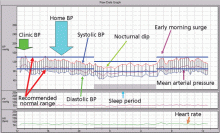Beyond office sphygmomanometry: Ways to better assess blood pressure
ABSTRACTTo diagnose and manage hypertension optimally, we may need to do more than measure the patient’s blood pressure in the office using traditional sphygmomanometry. A variety of devices—some already available, validated, and reimbursable, some still in development—provide more information and give us a better picture of the patient’s true hypertensive status, degree of blood pressure control, and risk of end-organ damage.
KEY POINTS
- Traditional office blood pressure measurements have diagnostic limitations, since they are only snapshots of a very dynamic variable.
- Ambulatory 24-hour blood pressure monitoring is a useful and proven tool and can reveal nocturnal hypertension, a possible new marker of risk.
- Automatic devices can be used in the clinician’s office to minimize the “white coat effect” and measure blood pressure accurately.
- Pulse-wave analysis provides physiologic data on central blood pressure and arterial stiffness. This information may help in the early identification and management of patients at risk for end-organ damage.
DIPPING VS NONDIPPING
The mean blood pressure during sleep should normally decrease by 10% to 20% compared with daytime readings. “Nondipping,” ie, the lack of this nocturnal dip in blood pressure, carries a higher risk of death from cardiovascular causes, even if the person is otherwise normotensive.12,13 Nondipping is commonly noted in African Americans, patients with diabetes, and those with chronic kidney disease.
A study by Lurbe et al14 of patients with type 1 diabetes mellitus who underwent ambulatory 24-hour blood pressure monitoring found that the onset of the nondipping phenomenon preceded microalbuminuria (a risk factor for kidney disease). Data from our institution15 showed that nondipping was associated with a greater decline in glomerular filtration rate when compared with dipping.
The lack of reproducibility of a person’s dipping status has been a barrier in relying on this as a prognostic measure. White and Larocca16 found that only about half of the patients who appeared to be nondippers on one 24-hour recording still were nondippers on a second recording 4 to 8 weeks later. Compared with nondipping, nocturnal hypertension is a more stable blood pressure pattern that is being increasingly recognized in patients undergoing 24-hour blood pressure monitoring.
AUTOMATIC BLOOD PRESSURE DEVICES
An automated in-office blood pressure measurement device is one way to minimize the white coat effect and obtain a more accurate blood pressure assessment. Devices such as BpTRU (BpTRU Medical Devices Ltd, Coquitlam, BC, Canada) are programmed to take a series of automatic, oscillometric readings at regular intervals while the patient is left alone in a quiet room. BpTRU has been validated in several clinical trials and has been shown to overcome the white coat effect to some extent. Myers et al17 compared 24-hour blood pressure readings with those obtained by a family physician, by a research technician, and by the BpTRU device and found that the BpTRU readings were much closer to the average of awake blood pressure readings on 24-hour blood pressure monitoring.
AMBULATORY 24-HOUR BLOOD PRESSURE MONITORING
- Presence or absence of the nocturnal dip (the normal 10% to 20% drop in blood pressure at night during sleep)
- Morning surge (which in some studies was associated with higher incidence of stroke)
- Supine hypertension and sudden fluctuations in blood pressure seen in patients with autonomic failure.
Studies have shown that basing antihypertensive therapy on ambulatory 24-hour blood pressure monitoring results in better control of hypertension and lowers the rate of cardiovascular events.18,19
Perloff et al18 found that in patients whose hypertension was considered well controlled on the basis of office blood pressure measurements, those with higher blood pressures on ambulatory 24-hour monitoring had higher cardiovascular morbidity and mortality rates.
More recently, Clement et al19 showed that patients being treated for hypertension who have higher average ambulatory 24-hour blood pressures had a higher risk of cardiovascular events and cardiovascular death.
After following 790 patients for 3.7 years, Verdecchia et al20 concluded that controlling hypertension on the basis of ambulatory 24-hour blood pressure readings rather than traditional office measurements lowered the risk of cardiovascular disease.
‘Normal’ blood pressure on ambulatory 24-hour monitoring
It should be noted that the normal average blood pressure on ambulatory 24-hour monitoring tends to be lower than that on traditional office readings. According to the 2007 European guidelines,21 an average 24-hour blood pressure above the range of 125/80 to 130/80 mm Hg is considered diagnostic of hypertension.
The bottom line on ambulatory 24-hour monitoring: Not perfect, but helpful
Ambulatory 24-hour blood pressure monitoring is not perfect. It interferes with the patient’s activities and with sleep, and this can affect the readings. It is also expensive, and Medicare and Medicaid cover it only if the patient is diagnosed with white coat hypertension, based on stringent criteria that include three elevated clinic blood pressure measurements and two normal out-of-clinic blood pressure measurements and no evidence of end-organ damage. Despite these issues, almost all national guidelines for the management of hypertension recommend ambulatory 24-hour blood pressure monitoring to improve cardiovascular risk prediction and to measure the variability in blood pressure levels.







